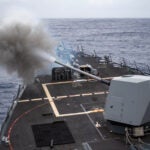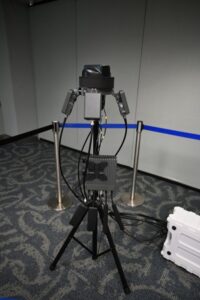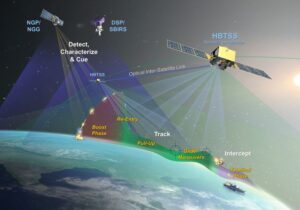
BAE/Canada. Canada has awarded BAE Systems’ Bohemia Interactive Simulations (BISim) subsidiary an enterprise license contract to provide its Digital Virtual Trainer (DVT) capability for the Canadian Army, the company said on Aug. 25. BAE Systems said Canada’s DVT program is intended to provide “immersive, flexible and highly scalable synthetic training” and that BISim’s solution is built around its “ecosystem of simulation products.” “…The DVT solution empowers Canadian Army personnel to plan, rehearse, execute, and review complex missions in immersive virtual environments across the globe through realistic first-person training experiences and large-scale collective training exercises,” BAE Systems said in a statement.
Pressure on Israel. Rep. Adam Smith (D-Wash.), ranking member on the House Armed Services Committee, said on Aug. 26 he would support the U.S. halting the sale of some offensive weapons to Israel as a means of placing pressure to implement a ceasefire, “massively increase” the flow of humanitarian aid into to Gaza and to “stop the expansion of settlements in the West Bank and take serious steps to reduce the violence there.” Smith noted his position supporting Israel while adding it’s “impossible to see how further military action in Gaza could degrade Hamas’ capabilities to any appreciable degree further than what has already occurred.” ”Nothing more can be realistically accomplished by Israel continuing the war in Gaza, and the humanitarian crisis there must be addressed,” Smith said. Sen. Bernie Sanders (I-Vt.) proposed measures in late July to block Israeli arms sales. Although those were defeated, they picked up support from more than half of the upper chamber’s Democrats for the first time.
Direct Support Fires. The Army’s Combat Capabilities Development Command Aviation & Missile Center (DEVCOM AvMC) on Aug. 26 held an industry day with 46 companies to detail its Direct Support Fires Technology (DSFT) science and technology project. DEVCOM AvMC said it discussed the Army’s need for “low-cost, massed produced rockets that are compatible with current and future launchers and will be intended to provide highly responsive massed reinforcing fires to Field Artillery Formations.” The industry day also included detailing a “novel approach that will empower industry partners to cross collaborate with each other while supporting the DSFT mission.” “The intent is to not do business as usual but create an ecosystem to leverage the DEVCOM AvMC reference design and body of knowledge, utilizing Cooperative Research and Development Agreements, and then iteratively demonstrate DSFT technologies,” DEVCOM AvMC said in a statement.
Ultra-Compact APU. LiquidPiston said on Aug. 27 it’s developing an ultra-compact auxiliary power unit (APU) for mobile command posts under an Army Small Business Innovation Research (SBIR) CATALYST award worth at least $15 million. The project is in support of the Army’s Mobile And Survivable Command Post initiative. LiquidPiston said its solution is a vehicle-mounted, ultra-compact 10-kilowatt APU based on its 10 kW portable electric generator platform, “powered by its basketball-sized, 25-horsepower, heavy-fueled XTS-210 X-Engine.” “We’re very proud and excited to be able to continue to mature our X-Engine and power systems platforms in support of the U.S. DoD’s initiatives to provide operational energy to our warfighters who need to be constantly on the move in contested logistics environments,” Alec Shkolnik, co-founder and CEO of Liquid Piston, said in a statement. “Our innovation and product development efforts are focused on enabling smaller, lighter portable and vehicle-mounted power systems which operate efficiently on military-grade and other fuels.”
AIM-9X FMS. The State Department said on Aug. 27 it has approved a potential $103.9 million foreign military sale with the NATO Support and Procurement Agency covering 96 AIM-9X Sidewinder missiles for Belgium, Italy and Romania. The deal for RTX-built AIM-9X Block IIs specifically covers eight missiles for Belgium, 24 for Italy and 64 for Romania. Under the deal, Romania would also receive 12 AIM-9X tactical guidance units. The FMS case also includes missile containers and engineering, technical, training and logistics support services. “The proposed sale will improve NATO’s capability to meet current and future threats by utilizing air-to-air missiles and guidance units for its F-35 fleets in support of NATO’s defense mission,” the Defense Security Cooperation Agency said in a statement.
Critical Technologies Trim. Undersecretary of Defense for Research and Engineering Emil Michael is looking to trim the current list of 14 critical technologies and create Critical Technology Areas (CTAs) that are more “digestible” for people, he said at a National Defense Industrial Association conference last week. Instead of roadmaps, Michael soon plans to launch sprints for the CTAs to sort out “what can we achieve in the next two to three years” for warfighters. “I need the component I lead to also be on the front end, delivering something to the war fighter that’s not sort of already existing,” he said. Michael noted that his predecessors have always added to the Critical Technologies List, which results in “the criticality gets diluted.” Items on the current list will remain important and receive funding but there will be fewer areas that people “wake up every day thinking about,” he later told reporters. The 14 technologies in the list, such as artificial intelligence and autonomy, are enablers for capabilities the military services need.
Small SDA Award. The Space Development Agency in August awarded Booz Allen Hamilton an $849,038 contract for a study to inform the ground segment and application factory of Tranche 3 of the Proliferated Warfighter Space Architecture (PWSA). Under the six-month award, Booz Allen will complete a feasibility study to help SDA evaluate a modular, loosely coupled modular open system architecture ground segment and app factory, the agency said.
People News. After Doug Beck was asked to resign as director of the Defense Innovation Unit, the Defense Department named Undersecretary of Defense Emil Michael as acting director, and Michael Dodd as acting deputy director. Michael also serves as DoD’s chief technology officer. HII last week expanded the responsibilities of Eric Chewning, making him executive vice president of maritime systems and corporate strategy. He joined HII in January 2023 from McKinsey & Co. to fill a new strategy position in the company’s leadership. He served as a chief of staff to the defense secretary during the first Trump administration. Finally, Voyager Technologies has hired Paul Tilghman as chief technology officer after working as chief engineer of connected warfare at Anduril Industries.
Ship Repair Partnership. Oregon-based Vigor Marine Group has formed a strategic partnership with South Korea’s Samsung Heavy Industries to help meet the U.S Navy’s needs for forward deployed ship repair and overhaul capacity in the Indo-Pacific region. “We understand the Navy’s evolving needs and have built a track record of delivering results in support of our national defense,” Francesco Valente, Vigor’s president and CEO, said in a statement. “Partnering with Samsung allows us to extend that same capability to forward-deployed operations in the Indo-Pacific and potential shipbuilding opportunities her in the U.S., helping the Navy increase its operational tempo while maintaining the highest quality standards.” The partnership includes exploring opportunities for Samsung to help Vigor return to its “shipbuilding roots in the Pacific Northwest,” Vigor said last week.
Taiwan Visit. Senate Armed Services Committee Chairman Roger Wicker (R-Miss.) and Sen. Deb Fischer (R-Neb.), the chair of the SASC strategic forces panel, started a Taiwan visit on Friday. Wicker’s office said that the senators are to meet with Taiwanese President Lai Ching-te, Vice President Hsiao Bi-khim, National Security Council Secretary General Joseph Wu, and other officials. Wicker said upon arrival in Taiwan that he was “glad to be here and to stand shoulder to shoulder with the free people of Taiwan as we work together to enhance their right to self-determination,” according to Wicker’s office.
Southern Partners for SOUTHCOM. U.S. Space Force Gen. Gen. Stephen Whiting, the head of U.S. Space Command (SPACECOM), said on Aug. 20 at the South American Defense Conference in Buenos Aires that the U.S. is pursuing multilateral cooperation, including from South American countries, to deter China and Russia. Whiting said that SPACECOM and U.S. Southern Command (SOUTHCOM) “have become excellent partners in space — working together for security cooperation and domain awareness.” Such projects include a $42 million infrastructure investment and the placement of 11 space domain awareness telescopes “with partners in South America,” said SPACECOM, adding that “China and Russia are seeking to establish space operation facilities in the Americas, likely including counter-space operations.”
Marauder. Saronic marked the keel laying of its first 150-foot Marauder autonomous surface vessel (ASV) during a ceremony on Aug 22, the company recently said. The event took place at its recently acquired Franklin, La., shipyard to mark the official start of production of the new class of vessels. The company acquired the Franklin shipyard earlier this year to be its “central hub for prototyping and rapidly producing Marauder and larger Autonomous Surface Vessels (ASVs) at scale,” Saronic noted in a statement. It reiterated Marauder will be the first vessel of its size to be designed from the start to be fully autonomous to offer a range of missions and a payload capacity of 40 metric tons at a range of 3,500 nautical miles or to loiter for over 30 days. The company plans to invest upward of $250 million at the shipyard to support a quick ramp-up to enable production of up to 50 vessels per year.
Sweeney At LMT. Lockheed Martin announced Chris Sweeney is joining the company’s Rotary & Mission Systems (RMS) business area on September 1st as the vice president of sustainment and growth initiatives. In this role he is directed to deliver performance reliability and support the full life cycle of customers’ platforms and products, “ensuring relevant capabilities at the lowest total cost.” Sweeney goes to Lockheed Martin following over 30 years of experience in the Navy, most recently as a two-star Rear Adm. as director of Integrated Warfare, N9I, on the OPNAV Staff for the office of the Chief of Naval Operations. Previously, Sweeney has experience as the Deputy Director for Policy, Plans, Strategy, Capabilities and Resources (J5/8) with U.S. European Command in Stuttgart, Germany and Director of Warfare Development (N7B/N72); Commander of Carrier Strike Group 11 with the USS Nimitz (CVN-68); and commander of Destroyer Squadron 15 from 2015 to 2016. “We are thrilled to welcome Chris to our team. His exceptional leadership and experience will deliver tremendous value to our customers, both here in the U.S. and around the world,” Dan Tenney, vice president of RMS strategy and business development, said in a statement.
Navy CIO Out. Department of the Navy Chief Information Officer (DON CIO) Jane Rathburn on Aug. 22 announced she is leaving the federal government after over 30 years in service, according to a LinkedIn post. Rathburn did not say why she is leaving the government or what first steps will be, but in response to a commenter asking what is next she said, “to be determined!!” Her successor, on an acting basis, is M. Barry Tanner, formerly the Deputy DON CIO. Before her last position, Rathburn was dual-hatted as the Deputy Assistant Secretary of the Navy for Information Warfare and Enterprise Services (DASN IWAR) under the ASN, RDA, and as Chief Technology Officer (CTO), DONCIO. Before joining the Navy Department, she served as Deputy Director for Defense Business Systems in the Office of the Deputy Assistant Secretary of Defense for C3, Cyber, and Business Systems (DASD C3CB) within the Office of the Under Secretary of Defense for Acquisition and Sustainment. Throughout her civilian government career, Rathburn served in various roles in IT reform and acquisition within the Defense Department and NASA.
THAAD 1,000. BAE Systems on Aug. 26 said it recently delivered its 1,000th infrared seeker to Lockheed Martin’s Terminal High Altitude Area Defense (THAAD) interceptor missile. The company’s THAAD seeker work occurs at its Nashua, N.H., and Endicott, N.Y., facilities. “At BAE Systems, we support our nation and its allies with the most advanced capabilities and technologies. The 1,000th THAAD seeker delivery reinforces our collaboration with Lockheed Martin and showcases our ability to deliver reliable next-generation targeting systems on time, enhancing precision-strike capabilities to counter emerging threats,” Neeta Jayaraman, product line director for Precision Guidance and Sensing Solutions at BAE Systems, said in a statement.
Caudle. Adm. Daryl Caudle assumed his new duties as the Chief of Naval Operations (CNO) during a ceremony on Aug. 25. Caudle most recently served as commander of U.S. Fleet Forces Command. President Trump ultimately nominated Caudle after Secretary of Defense Hegseth fired former CNO Adm. Lisa Franchetti without any public reasoning in February. Vice CNO Adm. James Kilby has been serving as Acting CNO in the interim six months, the longest ever period the Navy has not had a confirmed uniformed leader.
…New Fleet Design. During his first speech upon becoming CNO, Caudle said the Navy will be rolling out a new Future Fleet Design to be paired with the Navy Warfighting Concept, a new Navy Deterrence Concept and aligned with the investment priorities of the Navy Department. “The way we fight today will not be the way we fight tomorrow. We will relentlessly innovate, adapt, and accelerate the integration of cutting-edge technologies: Artificial intelligence; robotics and autonomous systems; resilient command-and-control networks; hypersonic weapons; advanced manufacturing; and quantum-enabled sensing. But perhaps, more important, we will synchronize these new capabilities in timing and tempo to deliver decision advantage, combat overmatch, and survivability in contested environments.
Viper Shield. Poland has picked L3Harris Technologies’ AN/ALQ-254 Viper Shield electronic warfare (EW) system as an upgrade for the country’s Block 52+ F-16 fighters, L3Harris said. The system “will equip Poland with the same advanced EW features available to other international allies operating the new F-16 Block 70 variant,” the company said. “L3Harris is offering Viper Shield in a variety of installation options, including the integration into the Block 70/72 aircraft and a retrofit version for previous F-16 blocks. Viper Shield is also available as an external pod. Designed to be software-defined, Viper Shield ensures battlefield relevance by supporting future capability upgrades. The company is providing this advanced suite to F-16 fleets in seven countries and is actively engaged in discussions with other U.S. allies and partner nations.”













